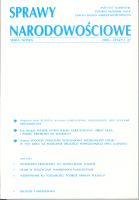Struktura wyznaniowa mieszkańców Polski w 1931 roku na podstawie drugiego powszechnego spisu ludności
The Religious Structure Of Poland's Population In 1931 Based On The Second National Census
Author(s): Tomasz WysockiSubject(s): Cultural Essay, Political Essay, Societal Essay
Published by: Instytut Slawistyki Polskiej Akademii Nauk
Keywords: Poland - national census 1931; religion; Catholic Church; religious minorities;
Summary/Abstract: This paper examines the religious diversity of Poland's interwar population. The results of the National Census of 9 December, 1931 provide the statistical database used in this analysis. Using the numerical material obtained from the aforementioned Census, the author projects the religious structure of the interwar population in Poland in relation to its nationality structure. This paper is also an attempt to determine the extent to which religion and mother tongue determined membership within a given nationality. It should be noted that the question of objectivity in classifying individual nationalities is quite problematic. In the course of national censuses, the respondents' declarations were (and are) affected by a variety of factors, e.g. mutual relations between the majority and minority groups in the given area. At times, some members of a minority group will not formally declare their minority identity. Additionally, declarations of identity may vary with respect to the respondents' needs. The author examines the interrelation between mother tongue and religion on the territory of the Second Polish Republic. Nationality groups can be identified by a variety of criteria. Frequently, the main criterion for identifying nationality is what the respondent declares to be his/her mother tongue. Another criterion may be the respondent's religion, which is frequently related to his/her mother language. It is quite interesting to examine the interrelation between the mother tongue, which is a subjective criterion of nationality, and a relatively objective criterion, e.g. the religious denomination. Roman Catholics represented the predominate religious group of the Second Polish Republic. That religion was generally identified with Polish nationality. Other faiths with relatively numerous representation in interwar Poland included the Orthodox Church, the Greek Catholic Church, and Judaism. Members of the Orthodox and Greek Catholic Churches were typically identified with East Slavic nationalities (Belorussians, Ukrainians, Ruthenians) and adherents of Judaism with Jews. The CHI2 tests of independence have shown that the nationality and religious population structures in the Second Polish Republic were closely linked.
Journal: Sprawy Narodowościowe
- Issue Year: 2005
- Issue No: 27
- Page Range: 71-98
- Page Count: 28
- Language: Polish

